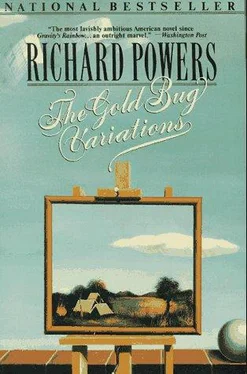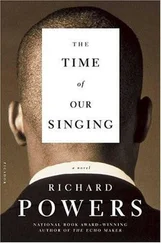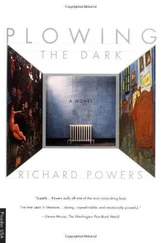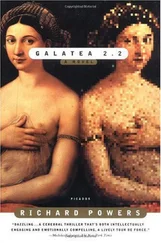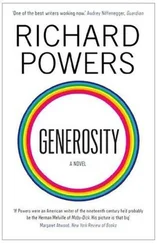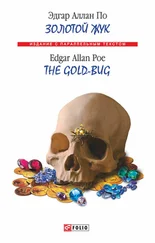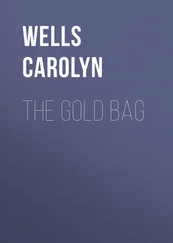Richard Powers - Gold Bug Variations
Здесь есть возможность читать онлайн «Richard Powers - Gold Bug Variations» весь текст электронной книги совершенно бесплатно (целиком полную версию без сокращений). В некоторых случаях можно слушать аудио, скачать через торрент в формате fb2 и присутствует краткое содержание. Год выпуска: 1991, Издательство: Harper Perennial, Жанр: Современная проза, на английском языке. Описание произведения, (предисловие) а так же отзывы посетителей доступны на портале библиотеки ЛибКат.
- Название:Gold Bug Variations
- Автор:
- Издательство:Harper Perennial
- Жанр:
- Год:1991
- ISBN:нет данных
- Рейтинг книги:5 / 5. Голосов: 1
-
Избранное:Добавить в избранное
- Отзывы:
-
Ваша оценка:
- 100
- 1
- 2
- 3
- 4
- 5
Gold Bug Variations: краткое содержание, описание и аннотация
Предлагаем к чтению аннотацию, описание, краткое содержание или предисловие (зависит от того, что написал сам автор книги «Gold Bug Variations»). Если вы не нашли необходимую информацию о книге — напишите в комментариях, мы постараемся отыскать её.
Gold Bug Variations — читать онлайн бесплатно полную книгу (весь текст) целиком
Ниже представлен текст книги, разбитый по страницам. Система сохранения места последней прочитанной страницы, позволяет с удобством читать онлайн бесплатно книгу «Gold Bug Variations», без необходимости каждый раз заново искать на чём Вы остановились. Поставьте закладку, и сможете в любой момент перейти на страницу, на которой закончили чтение.
Интервал:
Закладка:
He knows now what the man killed himself trying unsuccessfully to get out: How wonderful, to have had a child who might add to the endeavor. What a piece of work it all was. No sacrifice at all! Thirty volumes, a supplement, and an index. And all alphabetical.
This is what he's perjured. The world has grown another summer evening, one that seems the end of all summer evenings. He puts the Young Person's Guide to the Orchestra on the grinder. But neither the musical primer nor Olga's spinning convey anything to his leaden ear. Music fails him at the moment when he needs its compassion most. Autumn is here, an autumn that will spell the end of his front-lawn vigils. In town over two months; the pieces that hung so tantalizingly close to falling in place are farther now from linking than the day he arrived.
Already smelling the mixture of cold air and burning leaves that will mark the change of seasons, Ressler assigns himself penance, the only possible contrition. If one, clean, unimpeachable nugget lies anywhere within his ability to explicate, he will surrender it to Cyfer. First, the busywork rate experiment Ulrich has assigned him. Then, if chance favors, the simple laboratory technique for determining codon assignments, the leverage so agonizingly close that he can close his eyes and see it in the phosphene tracers on his lids. And not one discovery will be his.
However close he feels, he may never be any closer to the method than he is now, no closer than the baying kitchen mutt to the invading moon. His only means, not of adding his name to the volumes but of partially recovering perjured good faith, lies in returning to the puzzle, redoubling his efforts with focus so intense as to shame all effort he has yet made. He must place himself inside the isolated problem, feel its full, unrelenting force, cut himself off from rest, attach himself to the chance of not coming out, of never emerging from the search.
Another summer evening's knock at the door and Ressler assumes it is Tooney and Eva, through empathy of unpremeditated friendship, knowing to come and sit with him in his moment. The knock is them; humans are the only species that condition after one event. He stands, ready for companionship. He opens the door, jokingly asking Eva, "So what's the code for sickle-cell anemia?"
But it is not Blake or his remarkable Civil Service wife. In the doorframe stands the woman who set off this string of self-Contempt. Out where the welcome mat should be, incomprehensible, stands short-sleeved, full-bodiced Dr. Koss.
Facts on File
I believe it because it's absurd: the entire Britannica —not to mention the stacks of my old branch as well as the entire Library of Congress — can in theory be encoded by a single notch on a rod. The whole human reservoir can be condensed to a single information-bearing groove with no loss of meaning. A trillion pages, the complete journey from Aardvark to Zygote and back, enpacked, retrievable, in a flick of a nick on a stick.
No high tech, no microengraving or fantastic manipulation of silicon. Just a twig, a pocket knife, and a grade-school ability with numbers. Any text, however long and complex, is a linear stream of characters. Letters, punctuation marks, typograhic symbols: fewer than a hundred types. Each of these hundred can be replaced by a unique three-digit number. Simple substitution cipher, the sort even small children use for urgent communications. Montaigne's brutal truth "If we saw as much of the world as we do not see…" becomes 131 006 222 023 005 222 019 001 023 222 001 019 222…
So far, even the mathless boy I loved with all my plaintext heart could take this message and, in minutes, reverse-engineer the meaning from the emotionless series. Digitization is now a commonplace, long since the stuff of grocery-line conversation. As goes Montaigne, so goes the whole Britannica: the entire set now represented by a huge stream of codon digits, a giant, linear, ma-cromolecular, information-rich number.
Now the remarkable twist. If I run the triplets together and put a decimal point in front of the number, the result is a rational fraction running to millions of decimal places. But a fraction represents, and is represented by, a portion of any distance, say from one end of a stick to the other. My Montaigne number, 131006222023005222019001023222001019222…, along with my complete card box of quotes of the day for every day of the year attached to its tail, can now be committed to infinitesimally compact storage. I can incorporate my box of sayings in a discrete point a little farther than 13/100 of the way from tip to base. I might look at the mark from time to time, delighting in knowing that it encased the cycle of every famous saying ever to flesh out my calendar.
Alien, unnatural, counterintuitive. But analogous simplicity encodes a far more complex catalog. The map key, the compression that put life's Britannica, information intact, squarely in the palm of Ressler's hand, sweetly resembles that long, linear decimal.
Ressler himself worked out the math back in 1954, when the cell's translation game was fast becoming obvious. The math itself was easy: anyone with a little algebra could do it. DNA — a long, irregular decimal with A, T, G, and C as digits — consisted of innumerable bases lying in line on the inside twist of the helix. He had first to determine the width of the coding unit— how many digits of A, T, G, and C stood for one amino acid. This codon obviously had to be wider than one base. Codons one base wide could stand for only four different amino acids, and proteins required twenty. Two-base width allowed sixteen different codons:
AA AT AG AC TA TT TG TC GA GT GG GC CA CT CG CC
A vocabulary of sixteen was still four words shorter than required. Three successive rungs of the DNA ladder — sixty-four different combinations — at last produced enough codons to name all twenty aminos, with enough left over for start and stop codes or any other special symbols that protein-building might require. The triplet codon suffered an embarrassment of riches: forty-four more codons than amino acids. What to do with the extras became the sixty-four-codon-dollar question. More than one codon might stand for the same amino acid. Such code degeneracy might even carry potential survival value, as Ressler intuited early on.
In 1957, researchers learned how much easier it was to encode the Britannica than to experimentally extract from a given notched stick the particular Britannica it encoded. The giant informational molecule was the protein-constructing blueprint. The DNA base-pair sequences mapped out enzyme polypeptide chains. Ressler needed only intercept the map key. The unit word was a clump of at least three bases running along the half-DNA helix. No evidence strictly ruled out a larger codon, but most researchers applied the rule of parsimony. The next step was to determine exactly which triplet codon linked which amino acid to the enzyme under construction. Pure pattern-breaking attracted the lion's share of fascination: secret-message reading, ingenuity impeded by no encumbrance greater than paper and pencil.
The fearful symmetry of this structure gave a first glimpse of living logic. Ressler described to us the days on the threshold, poised on the brink of cracking the supreme philosophical crime novel. His voice rarely straying over the surrounding machine hum, he imparted his urgency for resolution. He compared his anxiety then to that anecdote about Bach entering a party where the harpsichordist broke off in terror at his arrival. The composer had to rush past his host to resolve the suspension with appropriate cadence before making his formal greeting.
"There had to be a surprising aha, a way we could get the cell to crack the code for us. That was my bias. It's pure torment to know that revolutionary, self-evident connections might be anywhere but here. We had no idea if a reliable method for determining codon assignments even existed. Some of us tried to tackle the problem theoretically, in ignorance of the data. On the other side of the tracks, retort heaters went about gathering data without grasping the formal problem. Like Brussels, Balzano: traffic signs so bilingually cluttered that neither camp could read them. My only advantage was that, fresh from school, I spoke just enough of both to put together something dangerous." He smiled weakly, at all that fluency hadn't prepared him for.
Читать дальшеИнтервал:
Закладка:
Похожие книги на «Gold Bug Variations»
Представляем Вашему вниманию похожие книги на «Gold Bug Variations» списком для выбора. Мы отобрали схожую по названию и смыслу литературу в надежде предоставить читателям больше вариантов отыскать новые, интересные, ещё непрочитанные произведения.
Обсуждение, отзывы о книге «Gold Bug Variations» и просто собственные мнения читателей. Оставьте ваши комментарии, напишите, что Вы думаете о произведении, его смысле или главных героях. Укажите что конкретно понравилось, а что нет, и почему Вы так считаете.
